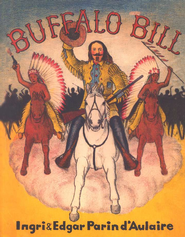 |
| Edgar and Ingri d'Aulaire |
Edgar met Ingri Mortenson at art school in Munich in 1921. The couple married in Norway, then moved to Paris. As Bohemian artists, they often talked about emigrating to America. “The enormous continent with all its possibilities and grandeur caught our imagination,” Edgar later recalled. They immigrated to New York in 1929.
The couple collaborated on their first children's book, The Magic Rug, at the suggestion of a New York city librarian in 1931. Next came three books - the first of which is Ola - steeped in the Scandinavian folktales of Ingri’s childhood in Norway.
 |
| What a cute book!!! source |
Next they shifted their attention to books featuring American heroes such as Pocohantas, Benjamin Franklin and Buffalo Bill, before turning to the realm of mythology.
The husband and wife team eventually produced over 20 picture books for children. The D'Aulaires established the picture book biography as a valued staple of library collections. They worked as a team on both the art and text throughout their joint career.
 |
| here - from Beautiful Feet Books |
Originally, the d'Aulaires used stone lithography for their illustrations. A single four-color illustration required four slabs of Bavarian limestone (one for each color), with each stone weighing up to two hundred pounds! The technique gave their illustrations a wealth of authentic detail and vibrancy.
 |
| source |
In the early 1960s, when this process became too expensive, the d’Aulaires switched to acetate sheets which closely mimicked the texture of lithographic stone. (Many of the old stones are now housed in the University of Minnesota's Kerlan Collection.)
The d’Aulaires' career spanned nearly five decades. They were working on a new book when Ingri died in 1980 at the age of seventy-five. Edgar continued working until he died in 1985 at the age of eighty-six.
Abraham Lincoln received a Caldecott Medal in 1940 and the d'Aulaires received the Catholic Library Association's Regina Medal for "distinguished contribution to children's literature." The D'Aulaire's Trolls was a New York Times outstanding book of 1971.
[sources: New York Review Books and The Children's Literature Network.]
Or their folklore collection? Norse Myths, Trolls, The Terrible Troll Bird - here, for ages 5-12.
 |
| here, for ages 5-12 |















































